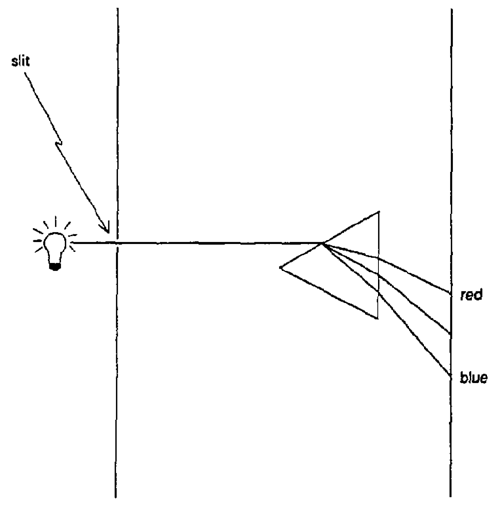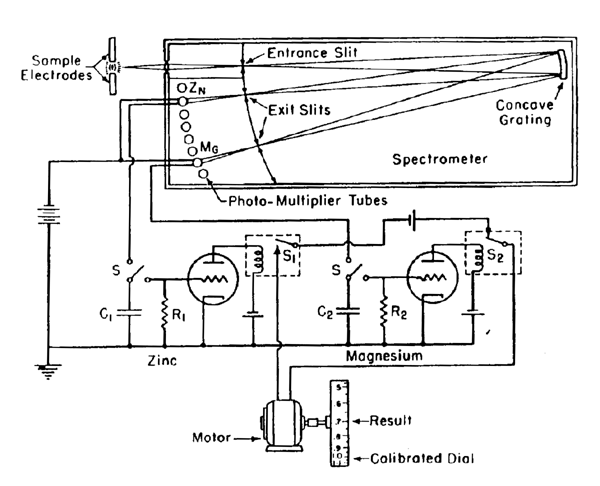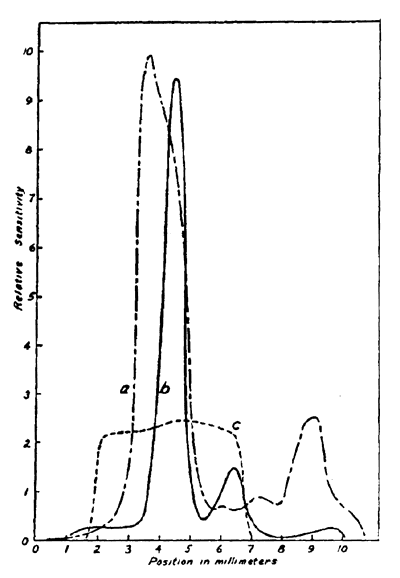SPT v3n3 - Encapsulating Knowledge: The Direct Reading Spectrometer
ENCAPSULATING KNOWLEDGE:
THE DIRECT READING SPECTROMETER
Davis Baird, University of South Carolina
1. INSTRUMENT EPISTEMOLOGY
In brief compass, I articulate and argue for what I call "instrument epistemology." This is the view that scientific instruments are themselves expressions of knowledge. I oppose the broadly Platonic—justified true belief—conception of knowledge. I oppose David Gooding in Experiment and the Making of Meaning when his first move is to ask how scientists "ascend from the world to talk, thought and argument about that world?" I oppose Walter Vincenti's choice to focus "on ideas rather than artifacts" in his What Engineers Know and How They Know It . Artifacts themselves, not just ideas, are expressions of knowledge.
In part, I argue by example. Direct reading spectrometers encapsulate into the material form of the instrument itself the skills and knowledge previously required of human operators. In the language of technology studies, direct reading spectrometers "de-skill" their operators. To do this, the instrument itself has to be "skilled."
In part, I argue by analysis and articulation. I advocate an approach to epistemology pioneered by Karl Popper. While Popper saw his "third world" of "objective knowledge" populated with propositional material—the stuff of theory—I argue that Popper's third world should include instruments as well. I close briefly examining the epistemology of a matrial third world.
2. SPECTRAL ANALYSIS

A spectrograph consists of five main parts: It starts with (1) a source of light, which could be the sun, the discharge of an electric arc, a flame, etc. This light is passed through (2) a narrow slit. Once through the slit, (3) a dispersing device—a prism or a grating—is used to separate spatially the different wavelengths of light. This dispersed light is then (4) focused on (5) some recording or observing surface. Passing the light through a slit produces images of a sharply defined line. By dispersing this light in two dimensions as a function of wavelength, a spectrometer produces multiple images of the entrance slit, each at a single wavelength. The placement of a slit image is a function of wavelength; one can determine the wavelengths of light present in the light source by noting the placement of the slit images, or spectral lines. Furthermore, the intensity of a spectral line is a function of the relative amount of light present at that line's wavelength.
Spectroscopy works as a method for chemical analysis because each element emits its own characteristic wavelengths of light. Thus, by looking at the wavelengths of light emitted, one can analyze the nature of the elements present in the light source. Metals, because they are hard to analyze by classical wet-chemical methods, turned out to be an important proving ground for spectrochemical analysis. Within the metals industry, speed is vital. Wet analyses take days, while spectrographic analyses take hours; direct reading takes minutes.
In a photographic spectrograph, photographic film is used to record the location and intensity of spectral lines. In a direct reader, photo-multiplier tubes and associated electronics directly measure line intensity. Operators needn't interpret photographs of spectral lines; the instrument directly displays the concentration of the elements of interest.
3.THE DOW CHEMICAL DIRECT READER
Direct reading spectrometers were developed simultaneously and independently at several sites during the mid-1940s. Here I focus on work done at the Dow Chemical Company by Jason Saunderson, Victor Caldecourt and Eugene Peterson. The Dow direct reader was developed for internal use in Dow's production of magnesium alloy.
By 1943, Dow was producing large quantities of magnesium alloy for airplane construction. Calcium was a critical element in magnesium alloy. If there was too little calcium, the metal would not roll properly; if there was too much, the metal would burn when welded. The tolerance was very narrow. Without a means to determine the amount of calcium in the melt before the alloy was poured, a large quantity of metal had to be scrapped. Wet chemical methods and photo-spectrographic methods were much too slow—"post-mortem methods." Saunderson conceived of substituting photo-multiplier tubes (then less than 10 years old) for photographic film to speed up the process.

Work to materially instantiate his idea began in January of 1944. An operational instrument was up and running by September. As is always the case, the path from idea to working instrument encountered difficulties. Consider two: an electrical and an optical problem.
Condensers: Condensers, attached to the photo-multiplier tubes, stored the charge generated by the tubes, thereby electrically encoding information about line intensity. It was critical to have condensers which would not leak charge, and which would not retain charge between runs. Saunderson and Caldecourt ran tests on the best commercially available condensers; they were not good enough. They developed a new condenser with a polystyrene dielectric (manufactured by Dow) which turned out to be ideal for their purposes. These condensers were then manufactured by special order for the direct reader.

Photo-Multiplier Tube Sensitivity: The cathodes which initially received the light in the photo-multiplier tubes turned out to be finicky. Curves (a) and (b) in Figure 3 , show how slight variations in where the tube's cathode received light resulted in large variations in the tube's output. Curve (c) was obtained when a ground quartz plate was used to "fuzz" the line over the cathode producing stable average sensitivity.
Saunderson's instrument was a great success. Within a month of its installation in the foundry basement it was routinely analyzing 4,000 samples of magnesium per month. In 1947, Dow licensed Baird Associates to manufacture and sell direct readers commercially. By the 1950s they were widely adopted in metals manufacture. In 1952, Saunderson was awarded the Willard H. Dow Memorial Award for Research in Magnesium for his work developing the direct reader.
4. EVOLUTIONARY EPISTEMOLOGY
How should we think about material expressions of knowledge such as the direct reader? Popper's "objective epistemology" holds the greatest promise. Popper argues for three distinct, autonomous but interacting "worlds:" the physical world—World 1—the world of (human and/or animal) thought or consciousness—World 2—and the world of objective contents of thought, objective knowledge—World 3. Popper describes the contents of World 3: "Examples of objective knowledge are theories published in journals and books and stored in libraries; discussions of such theories; difficulties or problems pointed out in connection with such theories; and so on." Human intellectual work draws on and contributes to World 3. It is through this interaction that we build and re-build World 3.
Popper's World 3 may seem some distance from the instruments with which I wish to populate my world of objective knowledge. As Popper describes it, World 3 is a product of language, particularly the descriptive and argumentative functions of language. Instruments are not linguistically built. On the other hand, some of Popper's other remarks about World 3 suggest the inclusion of instruments:
The tentative solutions which animals and plants incorporate into their anatomy and their behavior are biological analogs of theories; and vice versa: theories correspond (as do many exosomatic products such as honeycombs, and especially exosomatic tools, such as spiders' webs) to endosomatic organs and their ways of functioning. Just like theories, organs and their functions are tentative adaptations to the world we live in.
A direct reader surely is an exosomatic tool.
Both theories and instruments express knowledge of the universe. Theories express knowledge through the descriptive and argumentative functions of language. The direct reader expresses a knowledge of spectrochemical analysis that is an amalgam of theoretical understanding and skills working materials—know-how.
The key similarity that webs have with theories is their manner of coming into existence, Popperian "error elimination":
P 1 TT EE P 2
That is: a problem, P 1 —tentative theory—evaluative error elimination—problem P 2 .
Clearly both natural selection and the process behind the development of new theories and instruments are more complicated than this simple schema implies. Kuhn, Lakatos, and Feyerabend provide classic documentation of this point. Nonetheless, the concept of accuracy—and hence of its converse, error—plays a role, even if it is not fully determinative, in the development of scientific knowledge. The fit between product and the niche into which it is adapted, constitutes an expression of the knowledge this product provides of its niche. In the case of human knowledge, "error elimination" is a largely conscious process; in the case of spider webs, nature selects out errors. In either case, the resulting product exhibits knowledge of its particular niche, be it spectrochemical analysis of magnesium alloy production or capturing insects.
5. TRUTH AND FUNCTIONALITY
There are crucial differences between the linguistic products with which Popper populates World 3 and the instruments with which I am concerned. Here I consider what arguably is the most important: truth. Popper writes, "With the descriptive function of human language, the regulative idea of truth emerges, that is, of a description which fits the facts." We should seek true theories, and Popper offers an elaborate theory of verisimilitude as one way to understand error elimination. At the most elementary level, we want our theories to be accurate, true to the objects they claim to describe. Instruments do not describe; they perform. Thus, there is a question of what—if any—regulative ideal serves in place of truth. It is essential that there be one for evolutionary epistemology to operate, and, hence, for instruments to be expressive.
Propositional knowledge provides material for further theoretical reflection. These resources —sentences with content —are manipulated linguistically/logically/mathematically. Theoreticians are "concept-smiths," if you will, connecting, juxtaposing, generalizing and deriving new propositional material from given propositional material.
In the material world, functions are manipulated. In a spectrograph, photographic film is used to record spectral intensities, which are then read by the analyst. In a direct reader, the function of photographic film is replaced by photo-multiplier tubes. The function of reading the film for elemental concentrations is replaced by "condenser electronics." "Instrumenticians" are "function-smiths," developing, replacing, expanding and connecting new functionalities from given functionalities.
Ian Hacking's concept of a phenomenon, coupled with the instrumentician's purposive interest in the phenomena he or she seeks to develop and deploy, provides the best first analysis of a function. Hacking writes, "A phenomenon, for me, is something public, regular, possibly law-like, but perhaps exceptional." The phenomena that instrument construction requires are dependable regularities in material behavior. An instrumentician may have a detailed theoretical understanding of them. But this is not necessary.
Instruments have purposes, and the various parts of instruments have purposes which contribute to the larger purpose of the instrument. Thus, "instrumental purpose" must be coupled to the concept of a phenomenon to analyze the concept of instrumental function. This allows the substitution of one phenomenon for another radically different in nature, but which can fulfill the same function. The largely electrical phenomena of photo-multiplier tube behavior differs radically from largely chemical phenomena of photo emulsions. Yet both can be used to sense light.
We read the diagram (fig. 2, above) of the Dow direct reader functionally, not spatially or in some other manner. The diagram's symbol, C 1 , refers to the condenser which stores the charge generated by the zinc photo-multiplier tube. It has this function, although we have no idea from the diagram what C 1 looks like. (Polystyrene condensers were rather big, I understand.)
The eliciting, stabilizing, routinizing—black-boxing if you will—of a phenomenon is hard work. This fact has a corollary which bears on my current concern. Creating a phenomenon requires the same kind of adaptive Popperian error elimination as creating a theory. Where truth serves as a regulative ideal for theory construction, functionality serves for instrument construction. This is how instruments, "just like theories. . . are tentative adaptations to" their world, how they express knowledge.